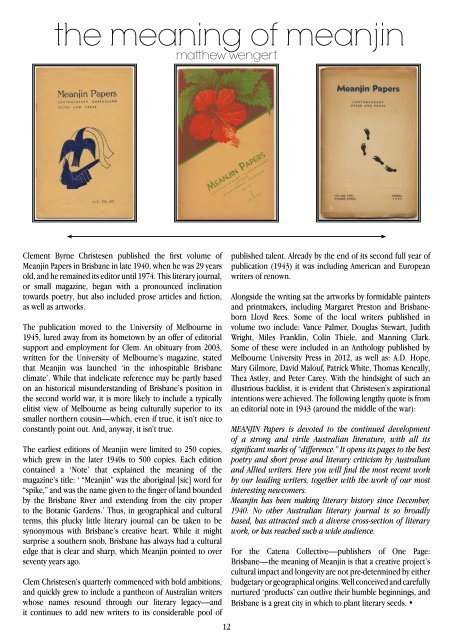one page: brisbane
You also want an ePaper? Increase the reach of your titles
YUMPU automatically turns print PDFs into web optimized ePapers that Google loves.
the meaning of meanjin<br />
matthew wengert<br />
Clement Byrne Christesen published the first volume of<br />
Meanjin Papers in Brisbane in late 1940, when he was 29 years<br />
old, and he remained its editor until 1974. This literary journal,<br />
or small magazine, began with a pronounced inclination<br />
towards poetry, but also included prose articles and fiction,<br />
as well as artworks.<br />
The publication moved to the University of Melbourne in<br />
1945, lured away from its hometown by an offer of editorial<br />
support and employment for Clem. An obituary from 2003,<br />
written for the University of Melbourne’s magazine, stated<br />
that Meanjin was launched ‘in the inhospitable Brisbane<br />
climate’. While that indelicate reference may be partly based<br />
on an historical misunderstanding of Brisbane’s position in<br />
the second world war, it is more likely to include a typically<br />
elitist view of Melbourne as being culturally superior to its<br />
smaller northern cousin––which, even if true, it isn’t nice to<br />
constantly point out. And, anyway, it isn’t true.<br />
The earliest editions of Meanjin were limited to 250 copies,<br />
which grew in the later 1940s to 500 copies. Each edition<br />
contained a ‘Note’ that explained the meaning of the<br />
magazine’s title: ‘ “Meanjin” was the aboriginal [sic] word for<br />
“spike,” and was the name given to the finger of land bounded<br />
by the Brisbane River and extending from the city proper<br />
to the Botanic Gardens.’ Thus, in geographical and cultural<br />
terms, this plucky little literary journal can be taken to be<br />
synonymous with Brisbane’s creative heart. While it might<br />
surprise a southern snob, Brisbane has always had a cultural<br />
edge that is clear and sharp, which Meanjin pointed to over<br />
seventy years ago.<br />
Clem Christesen’s quarterly commenced with bold ambitions,<br />
and quickly grew to include a pantheon of Australian writers<br />
whose names resound through our literary legacy––and<br />
it continues to add new writers to its considerable pool of<br />
12<br />
published talent. Already by the end of its second full year of<br />
publication (1943) it was including American and European<br />
writers of renown.<br />
Alongside the writing sat the artworks by formidable painters<br />
and printmakers, including Margaret Preston and Brisbaneborn<br />
Lloyd Rees. Some of the local writers published in<br />
volume two include: Vance Palmer, Douglas Stewart, Judith<br />
Wright, Miles Franklin, Colin Thiele, and Manning Clark.<br />
Some of these were included in an Anthology published by<br />
Melbourne University Press in 2012, as well as: A.D. Hope,<br />
Mary Gilmore, David Malouf, Patrick White, Thomas Keneally,<br />
Thea Astley, and Peter Carey. With the hindsight of such an<br />
illustrious backlist, it is evident that Christesen’s aspirational<br />
intentions were achieved. The following lengthy quote is from<br />
an editorial note in 1943 (around the middle of the war):<br />
MEANJIN Papers is devoted to the continued development<br />
of a strong and virile Australian literature, with all its<br />
significant marks of “difference.” It opens its <strong>page</strong>s to the best<br />
poetry and short prose and literary criticism by Australian<br />
and Allied writers. Here you will find the most recent work<br />
by our leading writers, together with the work of our most<br />
interesting newcomers.<br />
Meanjin has been making literary history since December,<br />
1940. No other Australian literary journal is so broadly<br />
based, has attracted such a diverse cross-section of literary<br />
work, or has reached such a wide audience.<br />
For the Catena Collective––publishers of One Page:<br />
Brisbane––the meaning of Meanjin is that a creative project’s<br />
cultural impact and longevity are not pre-determined by either<br />
budgetary or geographical origins. Well conceived and carefully<br />
nurtured ‘products’ can outlive their humble beginnings, and<br />
Brisbane is a great city in which to plant literary seeds. s



